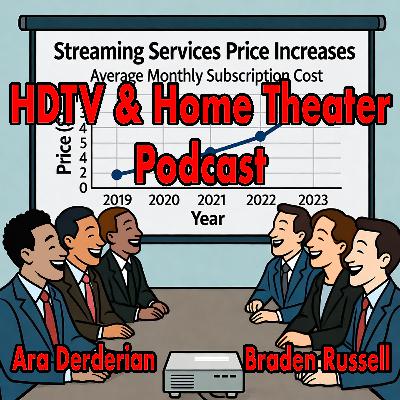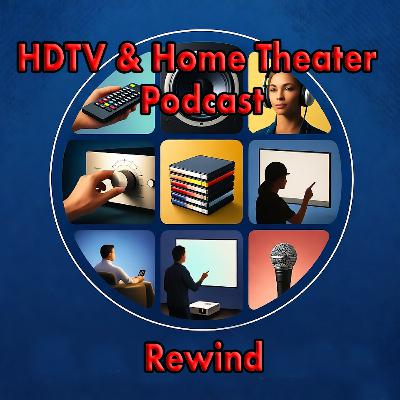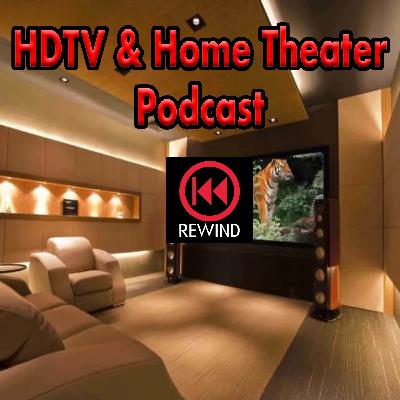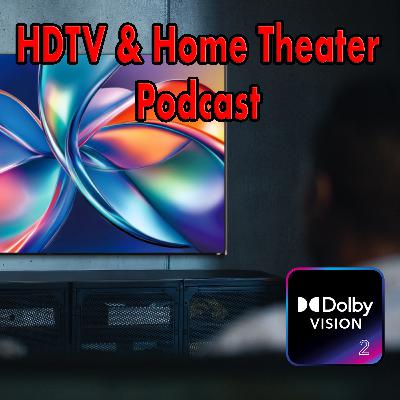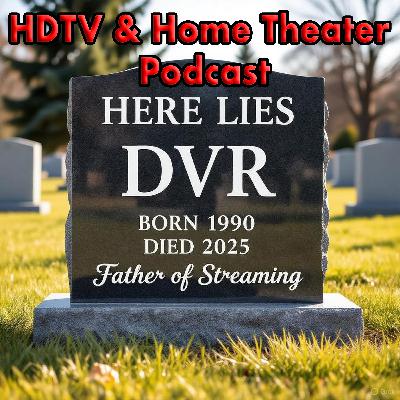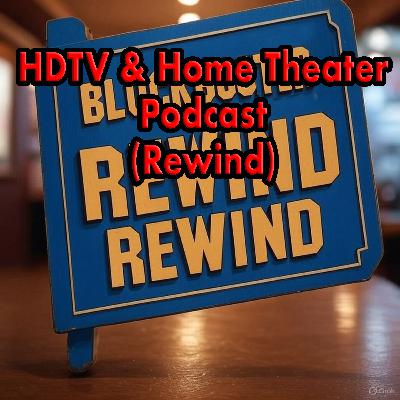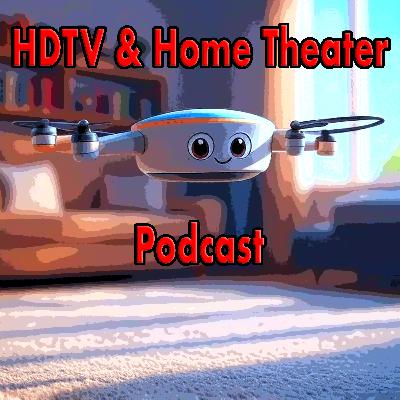Podcast #1226: What is Automatic Content Recognition (ACR)?
Description
On this week's show we have an essay from one of our listeners on why he wants to stick with his DVR over streaming. We also take a deep dive into Automatic Content Recognition and how to turn it off on your smart TVs. As usual we also read your emails and take a look at the week's news.
News:
- Disney pulls channels from YouTube TV as carriage deal expires
- DIRECTV now offering the Disney Bundle free to select customers
- TV Set-Top Box Losing Market Dominance
Please support Movember and enter to win great prizes from Bright Side Home Theater
Movember Raffle — Bright Side Home Theater
Swimming against the Stream - An essay from Jorge Beltran
I know I will sound old and swimming against current, but I would like to go back to my world where we had our cable subscriptions, DVR and Netflix. Simple, vs having to manage 5-7 subscriptions to watch what we want at a cost we can pay.
The proliferation of streaming services is turning out to be a way for content owners to extract more value from customers and significantly increase the amount of work customers have to do to find and track the content we want to watch. Even sports. Furthermore, it has backfired to content producers, with less opportunity to monetize content, driving them to look for economies of scale again.
I follow or used to follow La Liga, Premier League Soccer, ski, college football, and formula 1 racing. Back in the day I knew what channel carried all of these sports on my cable line up, would set it to record on my DVR and done. I could watch it when I wanted and where I wanted since I could access my DVR from anywhere but the plane.
Netflix was just growing and buying "older" content from the major networks and allowed us to binge watch old series we had missed. Some new exclusive content was coming out and that made paying the 10 - 12 $/mo a good value.
Fast forward to today:
The best games of Premier League have been taken off the over the air or regular cable channels are now behind a Paramount or someone else's paywall. Why am I going to pay for access to content that is mostly CBS that I can get over the air?. Worst of all, you can not skip commercials when you stream this content nowadays. You can't DVR the content and skip the commercials. I have lost track of who is now airing La Liga, but last time I checked was behind some other streamer. Fubo has a lot of soccer but is now super expensive too.
Conclusion: I have stopped following La Liga and Premier League. My enthusiasm for good Futbol has gone down tremendously. I turned my eyes to college football and Formula 1.
The worst part is that now I fear the same is going to happen with College Football, moving from free over the air or in basic cable channels to some exclusive need-to-pay streaming service. You guys praised Formula 1 going to Apple. I dread it!!! I do not pay for Apple TV(plus or not plus) and I catch Formula 1 over ESPN. Does it mean I will have to drop ESPN, that gives me other content and add AppleTV? If I were an NFL fan I would have lost it. Some content is on Amazon, other in the different networks or streamers. I do not know how much you have to pay to be able to watch the NFL consistently.
Call me old school. I still have a cable service that gives me the right to HBO, ESPN, Fox, and the likes. I can watch and record all the related content in Hulu from the major networks.
I only keep paying for Netflix that I see as a premium channel (like paying for HBO back in the day). Rationale - we get a lot of exclusive content there. I only keep the Disney/Hulu bundle cause it comes free with my wireless bill. And Amazon Prime (now with commercials) free for the shipping. But I barely watch Primer or Hulu cause I can't stand the commercials!
In a world with many streamers, the economies of scale enjoyed by bundling content in cable packages have been lost and thus it costs more per viewer for content owners to create and distribute given the less # of eyeballs. Yes, it sounds counter intuitive, but that translates into higher bills for consumers, through different bills but when you add it all up, it has to be more expensive, no way around it.
The positive is more content and innovation for sure. You can definitely find more quality content. But I foresee more partnerships coming to allow the industry to benefit from economies of scale and be able to distribute the cost of expensive content through more subscribers / viewers. Or they will have to continue to increase our subscription bills. I listened to an interview recently with a Hollywood producer detailing how cost efficient they have to be nowadays to be able to turn a profit on content produced given the lower number of ultimate viewers. This is a good thing, do not get me wrong.
But my point is we are coming full circle and a lot of inefficiencies have been introduced in the content value chain and made the experience more time consuming and difficult for viewers in the process. I think the industry has shot itself on the foot. Content that used to be free over the air is now behind a paywall and ALSO with commercials.
Apologies from my broken record
Long live my DVR!
Jorge
What is Automatic Content Recognition (ACR)?
Automatic Content Recognition (ACR) is built into most smart TVs (Samsung, LG, Vizio, Roku, Fire TV) and silently identifies everything you watch via your smart TV or any attached device via HDMI. It monitors your streaming, cable, and physical media. It will even identify any ads you watch. It grabs screen samples, sends them online, and feeds data to manufacturers, streamers, and advertisers for recommendations, targeted ads, and ratings. Usually on by default, it needs the internet to work. Privacy groups like the EFF warn it tracks your habits without clear ongoing notice.
How Does ACR Collect Data from Your TV Viewing?
ACR operates passively and continuously (or at set intervals) while the TV is on and tuned to a channel or app.
Here's a step-by-step breakdown of the process:
- Content Sampling: The TV's built-in software periodically "grabs" a short clip or snapshot of the audio, video, or both from what's currently displayed on the screen. This could be every few seconds or minutes, creating a digital "fingerprint" rather than storing full video. For example:
- Video fingerprinting: Analyzes pixels, colors, or scene changes (similar to how Shazam identifies songs).
- Audio fingerprinting: Listens for sound patterns in the broadcast.
- Watermarking: Detects invisible digital markers embedded in content by broadcasters or studios.
- This sampling works even for non-smart inputs, like cable or gaming consoles, because it captures whatever is output to the screen.
- Local Processing: The TV processes the sample on-device to generate a compact fingerprint. Raw clips aren't stored long-term on the TV itself—the data is anonymized to protect bandwidth and privacy (though critics argue these can still be re-identified when combined with other data like your location or device ID).
- Database Matching: The fingerprint is sent to the manufacturer's cloud servers where it's compared against a massive reference database. This database is built by:
- Monitoring live TV broadcasts in real-time via data centers.
- Cataloging known content like shows, movies, ads, and even timestamps for commercials. Matches reveal details such as the program title, channel, duration watched, and ad exposures.
- Data Aggregation and Transmission: Matched data is aggregated with metadata like your TV's IP address, viewing time, and household size. It's then used or shared:
- Internally for features like "fewer repetitive ads" or recommendations.
- With third parties like advertisers and Nielsen for ratings and for cross-device targeting which means you'll see the same ad on your phone after TV exposure.
The entire process is designed to be invisible and efficient, running without impacting TV performance noticeably.
Why Is This Data Collected?
- Personalization: To suggest shows/movies based on what you've watched.
- Advertising: Measures ad views for pricing, retargets viewers across devices, and optimizes campaigns.
- Measurement: Provides device-specific viewership stats, replacing outdated panel-based surveys.
TV Manufacturers Using Automatic Content Recognition (ACR) for Data Collection
| Manufacturer | ACR Usage Details | How to Disable (General Steps) |
| Samsung | Uses built-in ACR on Tizen OS smart TVs to track viewing behavior, including programs, ads, OTT apps, and gaming. Data supports ad retargeting and is used internally for recommendations. | Go to Settings > General > System Manager > Samsung Account > Privacy > Viewing Information Services > Toggle off. (10-37 clicks; also opt out via Comments In Channel |



